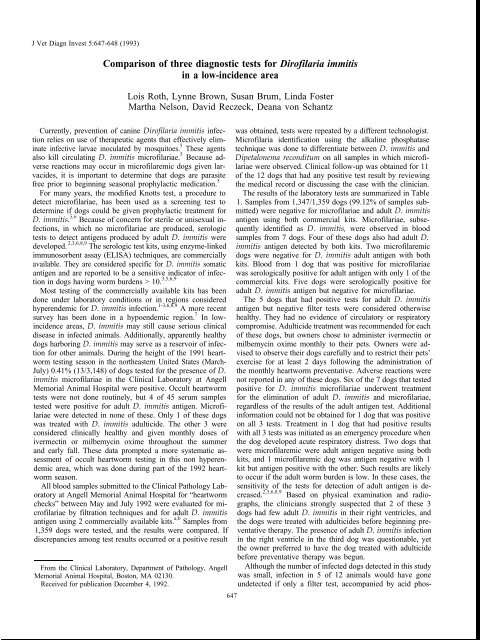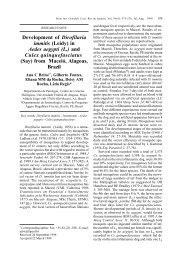o_196npoqgc1vmanrs38pbhti1ca.pdf
Create successful ePaper yourself
Turn your PDF publications into a flip-book with our unique Google optimized e-Paper software.
J Vet Diagn Invest 5:647-648 (1993)<br />
Comparison of three diagnostic tests for Dirofilaria immitis<br />
in a low-incidence area<br />
Lois Roth, Lynne Brown, Susan Brum, Linda Foster<br />
Martha Nelson, David Reczeck, Deana von Schantz<br />
Currently, prevention of canine Dirofilaria immitis infection<br />
relies on use of therapeutic agents that effectively eliminate<br />
infective larvae inoculated by mosquitoes. 5 These agents<br />
also kill circulating D. immitis microfilariae. 5 Because adverse<br />
reactions may occur in microfilaremic dogs given larvacides,<br />
it is important to determine that dogs are parasite<br />
free prior to beginning seasonal prophylactic medication. 5<br />
For many years, the modified Knotts test, a procedure to<br />
detect microfilariae, has been used as a screening test to<br />
determine if dogs could be given prophylactic treatment for<br />
D. immitis. 5,6 Because of concern for sterile or unisexual infections,<br />
in which no microfilariae are produced, serologic<br />
tests to detect antigens produced by adult D. immitis were<br />
developed. 2,3,6,8,9 The serologic test kits, using enzyme-linked<br />
immunosorbent assay (ELISA) techniques, are commercially<br />
available. They are considered specific for D. immitis somatic<br />
antigen and are reported to be a sensitive indicator of infection<br />
in dogs having worm burdens > 10. 3,5,6,9<br />
Most testing of the commercially available kits has been<br />
done under laboratory conditions or in regions considered<br />
hyperendemic for D. immitis infection. 1-3,6,8,9 A more recent<br />
survey has been done in a hypoendemic region. 7 In lowincidence<br />
areas, D. immitis may still cause serious clinical<br />
disease in infected animals. Additionally, apparently healthy<br />
dogs harboring D. immitis may serve as a reservoir of infection<br />
for other animals. During the height of the 1991 heartworm<br />
testing season in the northeastern United States (March-<br />
July) 0.41% (13/3,148) of dogs tested for the presence of D.<br />
immitis microfilariae in the Clinical Laboratory at Angell<br />
Memorial Animal Hospital were positive. Occult heartworm<br />
tests were not done routinely, but 4 of 45 serum samples<br />
tested were positive for adult D. immitis antigen. Microfilariae<br />
were detected in none of these. Only 1 of these dogs<br />
was treated with D. immitis adulticide. The other 3 were<br />
considered clinically healthy and given monthly doses of<br />
ivermectin or milbemycin oxime throughout the summer<br />
and early fall. These data prompted a more systematic assessment<br />
of occult heartworm testing in this non hyperendemic<br />
area, which was done during part of the 1992 heartworm<br />
season.<br />
All blood samples submitted to the Clinical Pathology Laboratory<br />
at Angell Memorial Animal Hospital for “heartworm<br />
checks” between May and July 1992 were evaluated for microfilariae<br />
by filtration techniques and for adult D. immitis<br />
antigen using 2 commercially available kits. a,b Samples from<br />
1,359 dogs were tested, and the results were compared. If<br />
discrepancies among test results occurred or a positive result<br />
From the Clinical Laboratory, Department of Pathology, Angell<br />
Memorial Animal Hospital, Boston, MA 02130.<br />
Received for publication December 4, 1992.<br />
647<br />
Based on physical examination and radiographs,<br />
the clinicians strongly suspected that 2 of these 3<br />
dogs had few adult D. immitis in their right ventricles, and<br />
the dogs were treated with adulticides before beginning preventative<br />
therapy. The presence of adult D. immitis infection<br />
in the right ventricle in the third dog was questionable, yet<br />
the owner preferred to have the dog treated with adulticide<br />
before preventative therapy was begun.<br />
Although the number of infected dogs detected in this study<br />
was small, infection in 5 of 12 animals would have gone<br />
undetected if only a filter test, accompanied by acid phos-<br />
was obtained, tests were repeated by a different technologist.<br />
Microfilaria identification using the alkaline phosphatase<br />
technique was done to differentiate between D. immitis and<br />
Dipetalonema reconditum on all samples in which microfilariae<br />
were observed. Clinical follow-up was obtained for 11<br />
of the 12 dogs that had any positive test result by reviewing<br />
the medical record or discussing the case with the clinician.<br />
The results of the laboratory tests are summarized in Table<br />
1. Samples from 1,347/1,359 dogs (99.12% of samples submitted)<br />
were negative for microfilariae and adult D. immitis<br />
antigen using both commercial kits. Microfilariae, subsequently<br />
identified as D. immitis, were observed in blood<br />
samples from 7 dogs. Four of these dogs also had adult D.<br />
immitis antigen detected by both kits. Two microfilaremic<br />
dogs were negative for D. immitis adult antigen with both<br />
kits. Blood from 1 dog that was positive for microfilariae<br />
was serologically positive for adult antigen with only 1 of the<br />
commercial kits. Five dogs were serologically positive for<br />
adult D. immitis antigen but negative for microfilariae.<br />
The 5 dogs that had positive tests for adult D. immitis<br />
antigen but negative filter tests were considered otherwise<br />
healthy. They had no evidence of circulatory or respiratory<br />
compromise. Adulticide treatment was recommended for each<br />
of these dogs, but owners chose to administer ivermectin or<br />
milbemycin oxime monthly to their pets. Owners were advised<br />
to observe their dogs carefully and to restrict their pets’<br />
exercise for at least 2 days following the administration of<br />
the monthly heartworm preventative. Adverse reactions were<br />
not reported in any of these dogs. Six of the 7 dogs that tested<br />
positive for D. immitis microfilariae underwent treatment<br />
for the elimination of adult D. immitis and microfilariae,<br />
regardless of the results of the adult antigen test. Additional<br />
information could not be obtained for 1 dog that was positive<br />
on all 3 tests. Treatment in 1 dog that had positive results<br />
with all 3 tests was initiated as an emergency procedure when<br />
the dog developed acute respiratory distress. Two dogs that<br />
were microfilaremic were adult antigen negative using both<br />
kits, and 1 microfilaremic dog was antigen negative with 1<br />
kit but antigen positive with the other. Such results are likely<br />
to occur if the adult worm burden is low. In these cases, the<br />
sensitivity of the tests for detection of adult antigen is decreased.<br />
2,3,6,8,9
648 Brief communications<br />
Table 1. Results of a filter test for Dirofilaria immitis microfi- tion. 4 Therefore, accurate detection of D. immitis infection<br />
lariae and 2 ELISA kits for adult Dirofilaria immitis antigen in 1,359 is clinically important, even in areas where heartworm disdogs.<br />
ease is relatively uncommon. In our hospital, only a filter<br />
concentration test is suggested for dogs given daily heartworm<br />
preventative medication during the “heartworm seaventative<br />
son”; an annual occult heartworm test alone is considered<br />
appropriate for dogs receiving year-round monthly treatments.<br />
Both tests are recommended for a dog given monthly<br />
preventative medication for only part of the year prior to<br />
initiating a preventative therapeutic schedule for the new<br />
“heartworm season.” A thorough physical examination should<br />
be an integral part of the diagnostic procedure. The dog’s<br />
history, use, and previous as well as future heartworm prethought<br />
medication regime are considerations when seson”;<br />
lecting the appropriate diagnostic tests for D. immitis infecphatase<br />
to be best suited for this study. There are several<br />
staining, was used. The modified Knotts test and the<br />
concentration filter technique used in this study are considtemporarily.<br />
Other therapeutic regimes may also cause<br />
ered sensitive for detection of D. immitis microfilariae. 5 The<br />
concentration filter test is a common method for microfilaria<br />
detection used by private practitioners in the area and is<br />
causes of antigen-positive, micrifilaria-negative infections that<br />
might explain these results. Continued use of monthly heart-<br />
worm preventatives may mask the presence of adults in dogs<br />
harboring D. immitis by rendering the adults sterile, at least<br />
tion in dogs.<br />
Acknowledgements. We appreciate the donation of diagnostic<br />
kits for Dirofilaria immitis adult antigen by Idexx Lab-<br />
oratories, Westbrook, ME, and by Symbiotics Corp., San<br />
Diego, CA, for use in this study.<br />
Sources and manufacturers<br />
Dirochek ® , Symbiotics Corp., San Diego, CA.<br />
Petchek ® , Idexx Laboratories, Westbrook, ME.<br />
References<br />
sterility of adult D. immitis. 9 Immune-mediated sterility of<br />
adult D. immitis also may be a factor in some cases. 9 1. Bowman DD, Johnson RB, Ulrich RE, et al.: 1992, Effects of<br />
The long-term administration of ivermectin or milbemycin oxime on<br />
presence of classical occult infections, characterized by the circulating microfilariae and parasitic antigeniemia in dogs with<br />
presence of a unisexual D. immitis infection, can cause dogs<br />
to be positive for adult heartworm antigen while remaining 2.<br />
patent heartworm infections. Proc Am Heartworm Soc, p. 36.<br />
Brunner CJ, Hendrix CM, Blagburn BL, Hanrahan LA: 1988,<br />
microfilaria negative. A prepatent infection is another, less Comparison of serological tests for detection of antigen in canine<br />
common cause of these results. 5,9 The dogs included in this heartworm infections. J Am Vet Med Assoc 192: 1423-1427.<br />
study were privately owned pets, and necropsy examinations 3. Courtney CH, Cornell JA: 1990, Evaluation of heartworm immunodiagnostic<br />
tests. J Am Vet Med Assoc 197:724-729.<br />
could not be done to determine the presence of adult D.<br />
4. Eaton KA, Rosol TJ: 1989, Caval syndrome in a Dirofilaria<br />
immitis. However, these 5 dogs were considered essentially<br />
immitis-infected dog treated with dicholorvos. J Am Vet Med<br />
healthy, and the owners preferred the risk of giving their dogs Assoc 195:223-224.<br />
a monthly heartworm preventative rather than treating them 5. Georgi JR, Georgi ME: 1992, Heartworms and other filarids.<br />
for adult D. immitis.<br />
In: Canine clinical parasitology, pp. 192-198. Lea & Febiger,<br />
Because < 1% of dogs included in this study were positive Philadelphia, PA.<br />
for either D. immitis microfilariae or D. immitis adult antigen,<br />
6. Greene RT, Bennett RA, Woody D, Troy GC: 1986, Evaluation<br />
dogs living in this locale should be considered at low of a microfilter technique and two serological tests used in the<br />
risk for the development of heartworm infection. Only 60 of diagnosis of canine heartworm disease. J Am Anim Hosp Assoc<br />
7,818 (0.77%) dogs from Colorado, another low-incidence 22: 153-156.<br />
area, were positive for D. immitis microfilariae. 7 7. Grieve RB, Frank GR, Mok M, et al.: 1992, Survey of heartworm<br />
In spite of<br />
(Dirofilaria immitis) infection in Colorado dogs: a model for surveying<br />
prevalence in hypoendemic areas. Proc Am Heartworm<br />
the low numbers, infection with D. immitis can cause serious<br />
clinical disease. Additionally, pets may accompany their soc, p. 14.<br />
owners to areas where heartworm infection is more common, 8. Grieve RB, Glickman LT, Bater AK, et al.: 1986, Canine Dirofilaria<br />
immitis infection in a hyperenzootic area: examination<br />
increasing the likelihood that they may become infected with<br />
D. immitis if appropriate precautions are not taken. 5,7 Selecting<br />
a safe heartworm preventive regime for any dog requires<br />
by parasitologic findings at necropsy and by two serodiagnostic<br />
methods. Am J Vet Res 47:329-332.<br />
that microfilaremic dogs, as well as dogs harboring 9. Rawlings CA, Dawe DL, McCall JW, et al.: 1982, Four types of<br />
adult D. immitis, be identified. Treatment of other conditions occult Dirofilaria immitis in dogs. J Am Vet Med Assoc 180:<br />
may also be contraindicated in dogs with D. immitis infec- 1323-1326.




